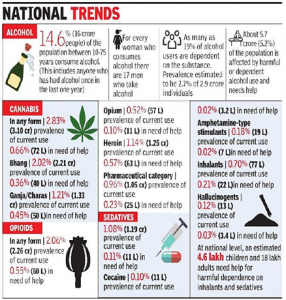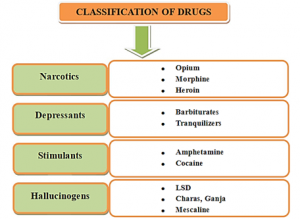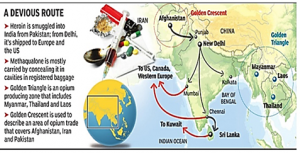THE CONTEXT: There has been an unprecedented upsurge in drug abuse in Indian society. The recent cases of drug abuse in Bollywood showcase the level of penetration of this menace. Also, north Indian states like Punjab have been grappling with the issue for quite some years.
FACT-CHECK ON DRUG ABUSE IN INDIA
- In February 2019, AIIMS submitted its report “Magnitude of Substance Use in India” to the Ministry of Social Justice and Empowerment. Key highlights of the report are:
- Alcohol is the most abused substance in India.
- Around 5 crore Indians reported having used cannabis and opioids at the time of the survey (conducted in the year 2018).
- It has been estimated that there are about 8.5 lakh people who inject drugs.
- Of the total cases estimated by the report, more than half of them are contributed by states like Punjab, Assam, Delhi, Haryana, Manipur, Mizoram, Sikkim and Uttar Pradesh.
- About 60 lakh people are estimated to need help for their opioid use problems.
- More and more children are taking to alcohol consumption and the highest percentage of children who are addicted to alcohol are in Punjab followed by West Bengal and Uttar Pradesh.
- Recently, in Punjab alone, nearly 35,000 cases were registered and over 42,000 persons arrested under the Narcotics Drugs and Psychotropic Substances (NDPS) Act and more than 1000 kg of heroin seized in the last three years by various state agencies.

ABOUT DRUGS AND THEIR ABUSE
The term ‘narcotic’ in the legal sense is quite different from that used in the medical context which denotes a sleep-inducing agent. Legally, a narcotic drug could be an opiate (a true narcotic), cannabis (a non-narcotic) or cocaine (the very antithesis of a narcotic, since it is a stimulant). The term ‘psychotropic substance’ denotes mind-altering drugs such as Lysergic Acid Diethylamide (LSD), Phencyclidine, Amphetamines, Barbiturates, Methaqualone, and designer drugs (MDMA, DMT, etc.).
WHAT IS DRUG ABUSE?
- WHO defines Drug Abuse as the harmful or hazardous use of psychoactive substances, including alcohol and illicit drugs.
- Addiction is an advanced stage of substance abuse where the addict develops a compulsion to take the drug, persists in its use despite harmful consequences and exhibits a determination to obtain the drug by almost any means.
- Psychoactive substance use can lead to dependence syndrome – a cluster of behavioural, cognitive, and physiological phenomena, which are marked by social withdrawal.
- Symptoms of addiction include loss of appetite and weight, loss of interest in day-to-day work, sweating, reddening of eyes, nausea or vomiting and body pain, drowsiness or sleeplessness and passivity, acute anxiety, depression, mood swings among others.

STIMULANTS: These drugs speed up the body’s nervous system and create a feeling of energy. They are also called “uppers” because of their ability to make you feel very awake. Stimulants have the opposite effect of depressants. When the effects of a stimulant wear off, the user is typically left with feelings of sickness and a loss of energy.
DEPRESSANTS slow down activity in the central nervous system of your body. These drugs are also called “downers” because they slow the body down and seem to give feelings of relaxation.
HALLUCINOGENS: When taking hallucinogens, switching emotions is frequent. These drugs change the mind and cause the appearance of things that are not really there. Hallucinogens affect the body’s self-control, such as speech and movement, and often bring about hostility.
Types of drugs include:
- LSD (lysergic acid diethylamide)
- Cannabis
PRESCRIPTION DRUGS can be very helpful drugs when used properly and when under the guidance of a qualified physician. These drugs can be used as aids in surgery, to treat medical conditions and while controlling various symptoms. Misuse and abuse of prescription drugs however can be very dangerous.
Types of drugs include:
- Opioids: Codeine, Oxycodone, Morphine
- Central nervous system depressants: barbiturates, benzodiazepines
- Stimulants: dextroamphetamine, methylphenidate
REASONS FOR DRUG ABUSE
FACTORS RESPONSIBLE
- Social factors: Easy availability of drugs, unstable home environment, inadequate parent supervision, use of drugs by peer groups, a part of the culture for heavy drinking & partying, highly competitive environment in schools & colleges
- Peer pressure and other psychological factors can cause teens to engage in risky behaviours, leading to substance abuse.
- Youth can get attracted to the glamour attached to drug-taking.
- Economic factors: Poverty and unemployment for example agrarian distress in Punjab
- Political factors: Ties between drug associations, organized criminal gangs, politicians and crook elements of the law enforcement agencies
- Sometimes people resort to drug abuse to overcome various problems like stress, anxiety disorders, physical ailment or even other forms of mental disorder
- The habit of landowners (such as in Punjab) supplying raw opium to farm labourers to make them to work harder, also has contributed to the problem
- Cross border drug trafficking from Pakistan, Afghanistan & Nepal
- Proximity to the largest producers of heroin – the Golden Triangle (Southeast Asia) and Golden Crescent (Afghanistan – Pakistan & Iran) is one of the main reasons for drug trafficking in India. Additionally, Nepal is also a traditional source of cannabis.
- India is both a destination and a transit route for drug traffickers in these regions.
- As a consequence of cross border smuggling, India has been affected by narco-terrorism.

- Glorification of drug abuse in media such as in series and movies- Popular media romanticizing drug use/abuse largely influences adolescents.
- Poor implementation of the NDPS Act and law and order.
IMPACTS OF DRUG ABUSE
- Social Impact
-
- Results in family violence, divorces, abuses and related problems
- On a larger scale, it is a threat to the social fabric of society as it results in increase in the crime rate
- Patients & their family members go through mental trauma & often are ostracized by the society
- Women in India face greater problems from drug abuse because of domestic violence
- Economic Impact
-
- Diversion of gov. resources to fight this problem which could have been used for social welfare programs
- Results in lost human productivity, such as lost wages and decreased production which results from illnesses and premature deaths
- A family member has to spend a lot of resources including time and money for the rehabilitation of their beloved ones
- Physiological/health Impact
-
- Physiological effects of drug abuse vary by the type of drugs
- Common symptoms include delay in sleep, nervousness and anxiety in the user
- If the abuser stops taking the drug, the body experiences withdrawal symptoms, such as feeling weak, sick, getting hyper and aggressive.
- Damage to organs, such as the heart, brain, and liver
- Diseases, such as heart disease, HIV, and cancer
- Development of mental illnesses, suicides
- Permanent changes to hormonal or nervous systems
- Crime:
-
- Resorting to monetary crimes to pay for drugs
- Increasing Incidences of teasing, group clashes, assault and impulsive murders. Drug abuse adversely affects the economic growth of a country by generating un-accounted money in large quantities that are also often used to fund terror and anti-national activities and therefore posing a serious threat to national security too
CONSTITUTIONAL, LEGAL PROVISIONS AND INTERNATIONAL AGREEMENTS
- According to Article 47, state is duty-bound to prevent the consumption of intoxicating drinks and drugs except for the consumption of it for medicinal purposes which are not injurious to health
- India is a signatory to three UN Conventions regarding drugs:
-
- Convention on Narcotic Drugs, 1961,
- Convention on Psychotropic Substances, 1971,
- Convention against Illicit Traffic in Narcotic Drugs and Psychotropic Substances, 1988
LEGAL PROVISIONS
- NDPS Act, 1985:
-
- The Act restricts cultivation, production, sale, purchase, possession, use, consumption, import, and export of narcotic drugs and psychotropic substances
- NDPS Act is a punitive and punishing statute. Punishment is based on the substance and its quantity found. Death penalty or 30 years of imprisonment for the repeated offence of drug trafficking
- It also contains a regulatory framework.
- The Act gives authority to the Central and the State government to frame rules in relation to drug-use activities.
- The regulatory framework also paves a way for the supply of opium, to registered users, for meditative purposes.
- The act also provides for rehabilitation. It further calls for the national fund for controlling drug abuse
- Prevention of Illicit Traffic in Narcotic Drugs and Psychotropic Substances Act, 1988
- It provides for detention in certain cases for the purpose of preventing illicit traffic in narcotic drugs and psychotropic substances and for matters connected therewith
- The government has adopted a multi-pronged strategy to deal with drugs control by establishing enforcement agencies like Narcotic Control Bureau (NCB), Narcotics Control Division, Department of Central excise & customs, revenue intelligence ¶-military and armed forces
- The Narcotics Control Bureau, under the Ministry of Home Affairs, coordinates actions by various functionaries (Central and State) under the NDPS Act.
- It has also constituted a joint committee to curb the menace of drug smuggling into India along international borders, which comprises four central ministries – Home Affairs, Health, Finance and Social Justice & Empowerment
- The State Governments also have their own Health Departments and Social Welfare Departments each of which has its own set of activities relating to Drug Demand Reduction.
ISSUES/CHALLENGES WITH DRUG CONTROL MECHANISM
- NDPS criminalizes drug use even though there is no such requirement under international conventions. People who are addicted to drugs need medical care and not jail.
- A thin spread of resources hinder rehabilitation measures.
- Rehabilitation:
- De-addiction centres are not fully equipped and health workers are not properly trained. Often the addicts are treated as prisoners.
- According to a recent Delhi State Legal Services Authority (DSLSA) Report, inmates are being ill-treated, subjected to sexual and physical torture, asked to perform sexual favours, and are not allowed to contact their families
- Post rehabilitation acceptance in society is also a major issue.
- Data: Reliability and accuracy of data provided by the National Crime Records Bureau (NCRB) and Narcotics Control Bureau is also a major issue.
- Despite the easy availability of drugs in Punjab, empirical data available on drug use seems to indicate that women appear to have resisted the urge to use drugs. (i.e.; no separate data of women drugs addict/users/peddlers)
- Even though we have many agencies to control illegal drugs, but there is a lack of an institutionalized mechanism for Joint Platform where the state police, BSF, DRI, NCB, Intelligence Bureau and other important agencies are represented. This joint platform could have helped in better coordination among various agencies, creating synergy and avoiding overlap in operations.
THE WAY FORWARD: EFFORTS TO ERADICATE MENACE OF DRUG ABUSE
ROLE OF MINISTRY OF SOCIAL JUSTICE AND EMPOWERMENT
- It is the nodal ministry for drug demand reduction that coordinates and monitors all aspects of drug abuse prevention which include assessment of the extent of the problem, preventive action, treatment and rehabilitation of addicts.
- It has the responsibility of creating awareness, educating people about the ill effects of drug abuse, its identification and rehabilitation.
- Information regarding the ill-effects of alcoholism and drug abuse is disseminated in regional languages through the All-India Radio programme “SanwartiJayen Jeevan Ki Rahen” and also through advertisements in newspapers.
- It supports activities of non-governmental organisations, working in the areas of prevention of addiction and rehabilitation of addicts and also funds Panchayati Raj Institutions (PRIs), Urban Local Bodies (ULBs), etc.
- The Ministry has been implementing the Scheme of Prevention of Alcoholism and Substance (Drug) Abuse since 1985, which stresses on developing culture-specific models for the prevention of addiction and treatment and rehabilitation of addicts.
- The Ministry celebrates International Day against Drug Abuse and Illicit Trafficking on 26th June every year. National Awards are also conferred to individuals and institutions in order to recognize the efforts and encourage excellence in the field of prevention of substance abuse.
- The Ministry has set up a National Toll-Free Drug De-Addiction Helpline Number 1800-11-0031 to help the victims of drug abuse, their family and society at large.
- CHETNA: is an NGO which runs an unofficial recreation centre for children inside the Nizamuddin Police Station. They mainly focus on developing friendly relations between the police and street children who are more susceptible to drugs and crime.
- The Delhi AIDS Control Society (DACS): suggested a plan in which more than 400 medical officers working in 260 Delhi government dispensaries and 150 specialists working in 32 Delhi government hospitals will be trained on a long-term basis at the Institute of Human Behaviour & Allied Sciences (IHBAS) as there was a scarcity of psychiatrists and trained manpower to tackle patients of drug abuse. They also advised keeping a strict check on the sale and purchase of addictive medicines available in pharmacies. The licenses of 20 shops had been cancelled in 2016 that sold such harmful drugs.
- Promotion of healthy Lifestyle
- There should be more penetration of the idea of a healthy lifestyle, especially in post-Corona times. There must be a renewed focus on Yoga especially for the youth so as to guide them away from the perils of Drug abuse.
- There must be more public figures participating in the fight against drug abuse. For exams like the recent ‘Fit India’ movement. This could bring much-needed behavioural change in society towards the menace of drug abuse.
- Value Education: Including a subject in the school curriculum about the ill effects of drug abuse and preventive methods will go a long way in solving this issue
- International experiences: India can consider experiences from European and Latin American countries while formulating and implementing legislation to stop drug abuse. In Europe and Latin American countries, it was found that non-punitive measures improved the health and well-being of drug addicts.
- Example: In Portugal, overdose and drug-related HIV infections got reduced after the decriminalization of drug use.
THE CONCLUSION: The Karnataka High court opined that the NCB should act like ‘Chanakya’ in addressing the menace of drug abuse. The issue needs an iron hand especially towards the sources of drug proliferation. To secure both presents as well as the future of our so-called demographic strength, the youth, the authorities must act like Chanakya, who completely removed the stump of grass from the root as it obstructed his movement. While the borders need more robustness for isolating India from the opium hot lands, the authorities within the territory must be more vigilant to curb the proliferation of substance.
Questions:
- Analyse the factors responsible for the menace of drug abuse in India. Suggest some measures that India could adopt to address the issue.
- What do you understand by Drug abuse? Examine India’s vulnerability towards Drug abuse and the legal and constitutional provisions in place to address the issue.

